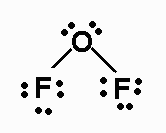
1. It takes 492 kJ of energy to remove one mole of electrons from the atoms on the surface of solid gold.
a) How much energy does it take to remove a single electron from an atom on the surface of solid gold?
(492 kJ/mol x 103J/kJ)/(6.022 x 1023/mol) = 8.17 x 10-19J
b) What is the maximum wavelength of light capable of doing this?
lambda = (h x c)/E
lambda = (6.626 x 10-34 J s x 2.998 x 108 m/s)/(8.17 x 10-19 J)
lambda = 2.43 x 10-7 m
2. Calculate the longest and shortest wavelengths of light emitted by electrons in the hydrogen atom that begin in the n = 6 state, and then fall to states with smaller values of n.
For longest lambda, n = 6 --> n = 5.
E = -2.178 x 10-18 (1/36 - 1/25) J = 2.665 x 10- 20 J
lambda = (h x c)/E
lambda = (6.626 x 10-34 J s x 2.998 x 108 m/s)/(2.665 x 10-20 J)
lambda = 7.454 x 10-6 m
For shortest lambda, n = 6 --> n = 1.
E = -2.178 x 10-18 (1/36 - 1/1) J = 2.118 x 10- 18 J
lambda = (h x c)/E
lambda = (6.626 x 10-34 J s x 2.998 x 108 m/s)/(2.118 x 10-18 J)
lambda = 9.379 x 10-8 m
3.a) In each of the following sets, which atom or ion has the smallest radius?
i) S, Cl, Kr
Size decreases across a period, and increases down a group. Cl is smallest.
ii) O, P, As
Size decreases across a period, and increases down a group. O is smallest.
iii) O+, O, O-
Cation is smaller than atom; anion is larger than atom. O+ is smallest.
b) In each of the following sets, which atom or ion has the smallest ionization energy?
i) Rb, Cs, Ba
I.E. decreases as go down a group, and increases as go across a period. Cs has smallest I.E.
ii) Ne, Cl, Ar
I.E. decreases as go down a group, and increases as go across a period. Cl has smallest I.E.
iii) O2-, O, O-
All three species have the same nucleus, but have differing number of electrons. O2- has smallest I.E.
c) Using data from Chapter 8 of Kotz and Treichel, determine, in kJ/mol, the ionization energy of Cl- and the electron affinity of Cl+.
The ionization energy of Cl- refers to Cl-(g) --> Cl(g) + e-
This process is the reverse of the E.A. for Cl(g).
I.E. here = +349.0 kJ/mol
The electron affinity for Cl+ refers to Cl+ + e- --> Cl(g)
Thi process is the reverse of the I.E. for Cl(g).
E.A. here = -1251 kJ/mol
4. For the following molecules and ions:
F2O, ICl4+, HPO42-, SeF4, PCl3, IBr3, HClO4, BrO3-
a) draw Lewis structures (including resonance forms where appropriate);
b) categorize each species according to the AXnEm nomenclature;
c) name the shape of the species;
d) predict whether those species which are neutral molecules will have a dipole moment;
e) for all the species that contain oxygen atoms, calculate the bond order of the central atom to oxygen bonds.
F2O
F2O has 20 valence electrons. Its Lewis structure is

The molecule is AX2E2, and has a bent geometry. It has a dipole moment. The two O-F bonds have B.O. = 1.
ICl4+
ICl4+ has 34 valence electrons. Its Lewis structure
is

The ion is AX4E, and has a seesaw geometry.
HPO42-
HPO42- has 32 valence electrons. Its Lewis structure
is

The ion is AX4 around P, and has a tetrahedral geometry. B.O. = 1.0 for P-O of P-O-H, and B.O. = 4/3 for P-O with no H.
SeF4
SeF4 has 34 valence electrons. Its Lewis structure is
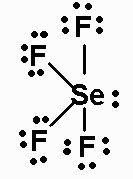
The molecule is AX4E, and has a seesaw geometry. It has a dipole moment.
PCl3
PCl3 has 26 valence electrons. Its Lewis structure is
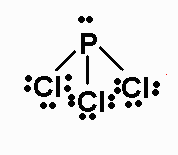
The molecule is AX3E, and has a triangular pyramidal geometry. It has a dipole moment.
IBr3
IBr3 has 28 valence electrons. Its Lewis structure is

The molecule is AX3E2, and has a T-shaped geometry. It has a dipole moment.
HClO4
HClO4 has 32 valence electrons. Its Lewis structure is

The molecule is AX4 around Cl, and has a tetrahedral geometry around Cl. It has a dipole moment. The Cl-O B.O. for the Cl-O-H bond is 1.0; the other Cl-O B.O.s are 2.0.
BrO3-
BrO3- has 26 valence electrons. Its Lewis structure
is

The ion is AX3E, and has a triangular pyramidal geometry. The Br-O B.O. is 5/3.
5. Draw resonance structures and predict bond orders and bond angles for the following:
a) NO2Cl (N is the central atom);
NO2Cl has 24 valence electrons. Its Lewis structure is

N-Cl has a B.O. of 1.0; N-O has a B.O of 1.5; all bond angles are 120o.
b) HSO3- (H is bonded to O);
HSO3- has 26 valence electrons. Its Lewis structure
is
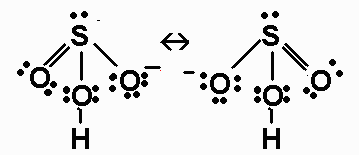
S-O B.O for S-O-H is 1.0; S-O B.O. for the other S-O bonds = 1.5. All bond angles are less than 109.5o.
6. Place the species below in the order of increasing bond length for the N-O bond;
H2NOH (N is the central atom, and one H is bonded to O), NNO,NO+, NO2-, NO3-.
The Lewis structures are:
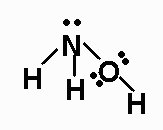
The N-O B.O. for H2NOH is 1.0.

The N-O B.O.for NNO is 1.5.

The N-O B.O. for NO+ is 3.0.
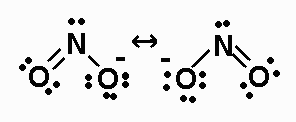
The N-O B.O. for NO2- is 1.5.

The N-O B.O.for NO3- is 4/3.
The order of increasing bond lengths is: NO+ < NO2- = NNO < NO3- < H2NOH.
7. 1.00 g PCl5 is introduced into a 250 mL flask, the flask is heated to 250øC, and the dissociation of PCl5 is allowed to reach equilibrium according to PCl5(g) = PCl3(g) + Cl2(g). The quantity of Cl2(g) present at equilibrium is found to be 0.250 g. What is the value of the equilibrium constant Kc for this reaction at 250oC?
Note that initial moles of PCl5 = 1.00 g/208.2 g/mol = 4.80 x 10-3 mol
| Moles | PCl5 | PCl3 | Cl2 |
| Initial | 4.80 x 10-3 | 0 | 0 |
| Change | -x | x | x |
| Equilibrium | 4.80 x 10- 3-x | x | x |
Note that problem states that x = 0.25 g Cl2/70.90 g Cl2 per mole = 3.92 x 10-3 mol
Kc = [x/0.250]2/[(4.80 x 10-3 - x)/0.250)]
Kc = (3.53 x 10-3)2/(0.250 x 1.27 x 10-3) = 3.92 x 10-2 mol/L